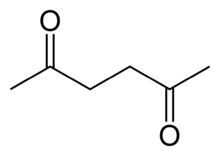Hexane-2,5-dione
 | |
| Names | |
|---|---|
| Preferred IUPAC name
Hexane-2,5-dione | |
| Other names
1,2-Diacetylethane 'α','β'-Diacetylethane Acetonyl acetone Diacetonyl 2,5-Dioxohexane 2,5-Diketohexane 2,5-Hexanedione | |
| Identifiers | |
3D model (JSmol) |
|
| ChEBI | |
| ChemSpider | |
| ECHA InfoCard | 100.003.400 |
PubChem CID |
|
| RTECS number | MO3150000 |
| |
| |
| Properties | |
| C6H10O2 | |
| Molar mass | 114.1438 g mol−1 |
| Appearance | colorless liquid |
| Density | 0.973 g cm−3, liquid |
| Melting point | −5.5 °C (22.1 °F; 267.6 K) |
| Boiling point | 191.4 °C (376.5 °F; 464.5 K) |
| ≥ 10 g/100 mL (22 °C) | |
| -62.51·10−6 cm3/mol | |
| Structure | |
| trigonal planar at carbonyl tetrahedral elsewhere | |
| Hazards | |
| Flash point | 78 °C (172 °F; 351 K) |
| Related compounds | |
Related diketones |
acetylacetone |
Except where otherwise noted, data are given for materials in their standard state (at 25 °C [77 °F], 100 kPa). | |
| Infobox references | |
2,5-Hexanedione (Acetonylacetone) is an aliphatic diketone. In humans, it is a toxic metabolite of hexane and of 2-hexanone.
Symptoms of poisoning
The chronic toxicity of hexane is attributed to hexane-2,5-dione. The symptoms are tingling and cramps in the arms and legs, followed by general muscular weakness. In severe cases, atrophy of the skeletal muscles is observed, along with a loss of coordination and vision problems.[1]
Similar symptoms are observed in animal models. They are associated with a degeneration of the peripheral nervous system (and eventually the central nervous system), starting with the distal portions of the longer and wider nerve axons.
Mechanism of action
It appears that the neurotoxicity of 2,5-hexanedione resides in its γ-diketone structure since 2,3-, 2,4-hexanedione and 2,6-heptanedione are not neurotoxic, while 2,5-heptanedione and 3,6-octanedione and other γ-diketones are neurotoxic.[2] In fact, higher α-diketones, like 2,3-pentanedione and 2,3-hexanedione, are found in small amounts in various foods. They are used as aroma components in alcohol-free beverages and in baked goods.[3]
2,5-Hexanedione reacts with critical lysine residues in axonal proteins by Schiff base formation followed by cyclization to give pyrroles. Oxidation of the pyrrole residues then causes cross-linking between two n-hexane-modified proteins. The resulting denaturation of proteins perturbs axonal transport and function and causes damage to nerve cells.[4]
Synthesis
A Process for preparing 2,5-hexanedione has been described:[5][6]
Uses
Acetonylacetone can be used in the synthesis of isocarboxazid,[7] rolgamidine,[8] and mopidralazine.
References
- ↑ Couri D, Milks M. "Toxicity and metabolism of the neurotoxic hexacarbons n-hexane, 2-hexanone, and 2,5-hexanedione" Annu. Rev. Pharmacol. Toxicol. 1982;22:145-66.
- ↑ Stephen R Clough; Leyna Mulholland (2005), "Hexane", Encyclopedia of Toxicology, 2 (2nd ed.), Elsevier, pp. 522–525
- ↑ Hardo Siegel; Manfred Eggersdorfer (2007), "Ketones", Ullmann's Encyclopedia of Industrial Chemistry (7th ed.), Wiley, p. 16
- ↑ Wolfgang Dekant; Spiridon Vamvakas (2007), "Toxicology", Ullmann's Encyclopedia of Industrial Chemistry (7th ed.), Wiley, p. 23
- ↑ U.S. Patent 3,819,714
- ↑ http://www.prepchem.com/synthesis-of-2-5-hexanedione/ Primary: Systematic organic chemistry, by W. M. Cumming, 194, 1937.
- ↑ U.S. Patent 2,908,688
- ↑ U.S. Patent 4,140,793